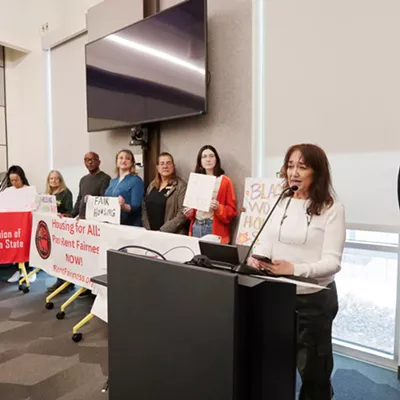So why then isn't the Interplayers production of The Woman in Black (through Oct. 28) more successful? Why is it, so often, not very scary?
Playwright Stephen Mallatratt's script goes into a long windup about the nature of reality and illusion, then gets all talky on us, even during its most sensational scenes. Then it telegraphs its ending badly, draining suspense out of the final minutes. There's much discussion of how retelling a tragic story will help exorcise its lingering demons; but really, sometimes, going on and on about creepy creatures just makes them overstay their welcome.
The two Damons in this cast, however -- Damon Abdallah as the Victorian gentleman haunted by ghosts and Damon Mentzer as the actor hired to help perform an exorcism through drama -- do commendable jobs with this material. Abdallah has the showier part, getting to play more characters and demonstrating his versatility with accents and body postures. He's an overworked Dickensian clerk, an invalid lawyer, a forbidding coachman, a hunchbacked old fogey, a distinguished landowner -- each nicely distinguished by voice and mannerisms. Mentzer (the shorter one) nicely differentiates his officious, skeptical actor from the fellow who later has to undergo a few nights in a mansion isolated deep in the Yorkshire marshes. Neither actor excels at their characters' horror-stricken moments, but that's at least partly because Mallatratt saddles them with a lot of self-talk about just how horrified they are.
The show is strong technically. Dan Heggem's lighting design slants sideways to cast oversize shadows, then proves especially versatile during one freaky nightmare sequence with lights flashing on and off all over. In a play set in the late 19th century and which refers often to the wonders of newfangled sound recording, Patrick Treadway's sound design has to work wonders, and it does: We hear the crisp sounds of the clock's ticking and the clip-clop of hooves on pavement. One m & eacute;lange of sound effects, just as it should be, is phantasmagoric. As director Ron Ford writes in his program note, "the sound and light effects amount to a third character in this production."
Ford's direction emphasizes that not all thrillers have to be gory, and his production -- a psychological mystery -- lives up to that standard. The Woman in Black is a thought-provoking show, perhaps too much so, because we can't get the bejeebers scared out of us while we're thoughtfully stroking our chins.
Mallatratt's plodding script sets us up at considerable length to meditate on the interpenetration of the real world and the theatrical one. He has his frightened man insist on dramatizing the scariest night of his life -- how exactly doing so will help him with ghostly shell shock is never explained, exactly -- and then he has his actor turn into the man, and the man into the actor. It's all very self-referential, you see.
But then Mallatratt undermines his own premise late in the play: As one actor twirls about the stage in fear, the other narrates the fearful things we're seeing. The playwright implores us to use our imaginations, then demonstrates that he doesn't trust us to use them at all. We're told about events even as we're watching them unfold, setting up a curious double-remove from a play that's trying hard to draw us in, wipe out the barrier between reality and fiction, then grab us by the throat, and oh my God!
Sorry, we must interrupt this terrifying moment so we can drone on and on, interpreting it for you.
All in all, too much telling, not enough showing. For a thriller, that's a death sentence. Watching The Woman in Black is like a having Victorian novel intermittently acted. It's like having a couple of actors interrupt the ghost story you're reading, just so they can do a scene or two. It's not a complete theatricalization of what originally was, quite obviously, a novel (by Susan Hill).
Some of the stuff that happens is appropriately mysterious and chilling (like whatever it is beyond that mysterious upstage scrim). I kept hearing strange noises all around me; even the fog machine makes a weird sniffing sound. A couple of sequences had me darting my eyes about in the darkness, trying to observe the scary bits before they could catch me by surprise. (I'm no 'fraidy-cat.) Ford's staging kept the boys moving, and there are some startling moments in the mist. The Woman in Black has its gripping moments, all right. They're just too scattered and too few.
















